FAQs about Yellow Tang
Disease/Health 13
FAQs on Yellow Tang Disease: Disease 1, Disease 2, Disease 3, Disease 4, Disease 5, Disease 6, Disease
7, Disease 8, Yellow Tang Disease 9, Yellow Tang Disease 10, Yellow Tang Disease 11,
Yellow Tang
Disease 12, Yellow Tang
Disease 14, Yellow Tang
Disease , & Paravortex/Black Spot
Disease,
FAQs on Yellow Tang Disease by Category:
Diagnosis,
Environmental, Nutritional,
Trauma,
Pathogenic (infectious, parasitic),
Social, Genetic,
Treatments
Related Articles: Yellow Tangs,Related FAQs:
Best Yellow Tang FAQs,
Yellow Tangs 1, Yellow Tangs 2, Yellow Tangs 3, Yellow Tangs 4, & Yellow Tang FAQs:
Identification, Behavior, Tang
Behavior, Compatibility,
Selection, Systems, Feeding, Reproduction, & Purple Tangs, Striped Sailfin Tangs, Zebrasoma Tangs, Zebrasoma Identification, Zebrasoma Behavior, Zebrasoma Compatibility, Zebrasoma Selection, Zebrasoma Systems, Zebrasoma Feeding, Zebrasoma Disease, Zebrasoma Reproduction, Surgeons In General, Tang
ID, Selection,
Compatibility,
Systems, Feeding, Disease, Fish Worms Diseases,
|
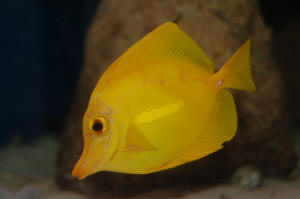
|
Surgeonfishes: Tangs for Marine Aquariums
Diversity, Selection & Care
New eBook on Amazon: Available here
New Print Book on Create Space: Available
here
by Robert (Bob) Fenner |
 |
|
Algae in tang barb 6/6/2015
Good day! I was cleaning the office tank of algae(was ill for a few weeks and am
the only tank tender) and a few days later I noticed something caught on the
yellow tangs' barb.
<Actually... appears to be some sort of post caudal peduncle spine injury.
Try blowing up the image as I have... is there another fish there that it "spars
with" at times?>
It looks to be a piece of algae and I am not sure of the best way to remove it
without undue stress to "Bubbles".
<I would NOT try to remove this... instead simply do your best to provide "good
conditions" (nutrition and water quality mostly), and this injury will heal in
time>
The tang does not appear to be bothered by it and has not been flashing.
Your input would be greatly appreciated. I have attached photos and hope they
are helpful.
Thank you
Kellie Kyser
<Thank you for sharing. Bob Fenner>
|
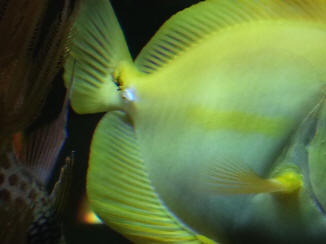
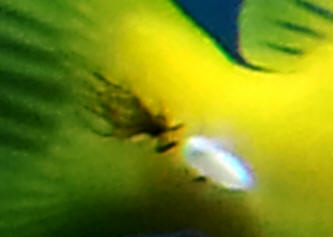
|
Re: Algae in tang barb 5/8/15
Good day again! I have not observed any sparring with the tank mates.
<Mmm; now I see the tang/barb itself appears to be broken (happens, and some
folks/collectors purposely snip off... with nail-clippers... to prevent the
catch from slashing each other)... will grow back>
There are 2 mated clowns, 2 Pajama Cardinals and 1 Flame Angel. However, what
goes on behind closed waters is another story. I have noticed that what is in
/on barb appears to be growing and it sways with motion. I have blown up the
pictures but the quality isn't very good. I will attempt better close up
pictures if needed. My boss purchased PraziPro but I am reluctant to use it.
<... for worms? Not to use>
Thank you for time and input.
Kellie Kyser
<Again, I urge (simple) patience here. Bob Fenner>
|
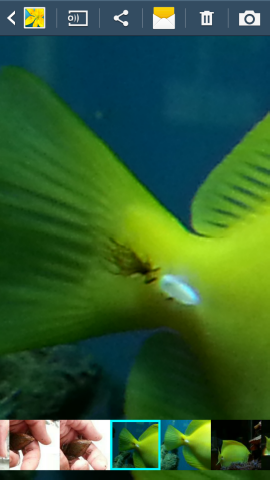
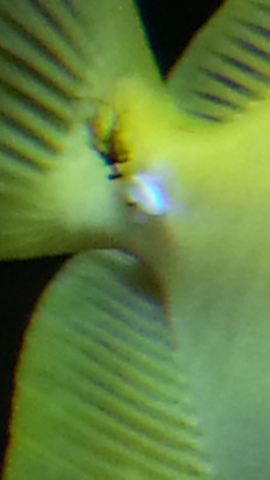 |
|
Growth on tang barb 6/27/15
Hi Bob..here are updated pictures of the (?) on the tang barb.
<11 Megs?!>
Again I apologize for the poor quality (the little bugger is quick!) Your answer
to my prior emails was a possible damaged barb.
<Will change my mind. This appears to definitely be filamentous algae growing on
the tang>
What ever is on there is definitely growing, is green in color and is attached
by 2 thin strands. When the fish turns, it almost appears to not be attached. I
added pictures from when it was smaller for growth comparison.
I have done water changes and made sure parameters are within specifications.
The diet includes San Francisco Bay Salt Water Multipack (mysis/brine shrimp,
veggies and squid) Ocean Nutrition 2 pellets, live mysis shrimp, Nori sheets and
live ghost shrimp for special treats (they love the thrill of the chase).
Thank you again for your help. Your site is a wealth of information.
Kellie Kyser
<Well; can; you could... catch this fish in a net, pull off the algae. Do take
care as it's really easy and painful to get slashed. I have collected thousands
of Yellows (in Hawaii) and some folks do make a practice of clipping (with small
finger nail clippers) Acanthurid tangs... to prevent slashing of crowded
specimens enroute and holding... Can be done safely; and the white tang will
regenerate. Bob Fenner>
|
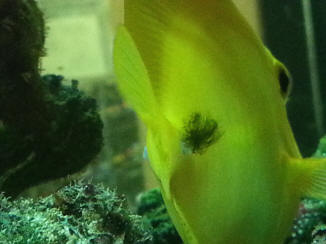 |
Re: Growth on tang barb 6/28/15
Thank you for getting back to me. I will attempt to catch the tang, however, I
will probably wind up having to rearrange the rocks as there are many caves and
arches I have made ( the flame angel loves to zip in and out) What would the
consequences be if I am unsuccessful in removing this algae?
<Zip>
It doesn't appear to bother the tang as I have not observed it flashing or
rubbing on the rocks. Could this be the result of a piece of algae getting
caught in the barb when I cleaned the tank?
<Possibly>
There was quite a bit of it due to no cleaning for almost a month. As always, I
greatly appreciate your help.
Kellie Kyser
<Ahh, either way, not likely the algae is doing the fish any harm. Cheers, BobF>
Re: Growth on tang barb 7/1/15
Hello! I am happy to report that the algae has been dislodged from the tang
barb..probably due to the clowns chasing it away from their nest area
<Heeeee!>
(female clown laid eggs..again) Thanks again for answering all of my questions.
Kellie Kyser
<Thank you for this follow-up Kel. Bob Fenner>
|
Yellow tang problem. Poor grammar, no reading
10/15/14
Hiya im hoping that u can help with a problem i have,my main tank was
infected with marine ich and some of the fish were showing signs so i
put them in a hospital tank and conducted hypo treatment for 6wks.
<Not a fan. Rarely works in the long term>
they have now been in normal s.g for the past two wks and all was fine
except the last couple of days my yellow tang has rapid breathing and
now a slight orange patch near her tail,she is still eating,i dont see
any spots on her or any of the fish,your help would be much appriceated
as im not sure what to do next,
<Search, read on WWM re these issues>
<Likely the Hypo destroyed too many hemocytes... only time and
good care will show if this fish survives, the others remain Crypt free.
Bob Fenner>
re: Yellow tang problem 10/15/14
Thank you for your quick response.would you reccomend a fw dip?or should
i place her back into the dt and see if that helps?Again thank you for
your
help
<I'd skip the dip and any further med. use, and place the fish back in
the main/display. BobF>
thank you emma
|
Yellow tang. Hlth., no data
9/1/14
I have a yellow tang that seems to act health but has a few small red
dots on his dorsal fin ( see below ). Any ideas what this could be and
the cause.
Thanks
<Mmm; well... could use data... re the system, water quality test
results, foods/feeding, tankmates.... the frayed dorsal fin and white
chest patch... might indicate some issue/s with the system; perhaps
bullying, lack of nutrition. Let's just have
you read:
http://wetwebmedia.com/YTangDisDiagF.htm
and the linked files above. Bob Fenner>
|
%20ye%20tang.jpeg) Re: Yellow tang.
9/1/14
Bob thanks for such a quick reply. You guys are do great.
So about the lack of info:
My tank is: 72gal sump 20gal 1/2 filled , PH 8.2, SG 1.24-1.25, Ammonia 0,
Nitrite 0, Nitrate 20, temp. 80degF , 29 ponds of live rock, 3 blue legged
hermits, 6 Snail , 3 clown , 1 green goby, 1 yellow tail damsel, 1 yellow tang.
Loss 1 coral beauty one month ago and loss 1 rainbow rasp 2 month ago. Got tank
in April 2014. Been fighting the nitrate at 20 for a few months so feeding once
a day, Fish finish eating in about 5 mins.
<Do see WWM re Yellow Tang feeding... this fish is thin; malnourishment, lack of
nourishment may be the real problem here>
Please let me know what other info would be helpful.
Thanks for all your help and knowledge.
John
<Glad to share. BobF>
|
Zebrasoma Flavescens in quarantine
6/11/14
Hello again Mr. F.
<Mr. A>
A quick question: I have 2 Zebrasoma flavescens in quarantine
for well over 2 weeks now and they looked very good since day
one, absolutely no white spots on them, are eating very good , they
actually got fat , I fed them a lot and they have live rock covered with
algae in there and they always graze around. There is no flashing, but
the only problem is that from the beginning they seem to breath very
rapidly. At first I thought they were scared
<A week is more than long enough with most all Surgeons; esp. Zebrasoma
spp.... And yes to being stressed in quarantine settings; much more to
be lost in delaying... move them>
and adapting but they still do it, even if they come and eat while I am
there so they are no longer afraid.
I know ( too well unfortunately ) that this could be a sign of
Cryptocaryon or even worse Amylodium but is the only sign and as I told
they are eating and grazing all day.
<Highly doubtful>
When could I introduce them to the DT? Do you think there is reason to
worry? Anyway I always dip in freshwater and blue Methylene before
introduction to the DT, but I have in there very valuable and sensitive
fishes and I don`t know what to do.
Thank you,
Andrei from Romania
<I would move these and all fishes through the proscribed pH adjusted
freshwater bath (likely w/ formalin) enroute... and do this NOW. Bob
Fenner>
Yellow tang and gastrointestinal parasites
5/13/14
Hello Wet Web Media crew,
I've been having some problems with my Yellow tang. I've had him for two
years but in the last 6 weeks he has not been well. It started with him
losing his appetite and staying in one spot in the tank which is a 125
gallon reef. I started noticing that when i fed the fish at night and
gave the tang his Nori he was barely eating. There were no visible signs
of any parasites. I did see that his feces was <were> white and stringy
looking.
After doing some research I figured that he probably has some sort of
gastrointestinal parasites.
<Maybe; but this does not necessarily follow given the stated
symptoms...
I.e., could be due to nutritional, psychological issues>
He was treated in a quarantine tank for 10 days with 250 mg of
Metronidazole per day with 50 % water change daily. Gradually he started
eating again and he was put back in the DT. Its been about 3 weeks now,
and he is beginning to look very skinny and sunken in and he isn't
eating much again. I'm not really sure how to proceed with treating this
fish. Any advice would be much appreciated.
Thank you
<I'd be offering a wide range of foods; with frequent to (as with algae)
constant offering. See WWM re Z. flavescens foods/feeding/nutrition
(FAQs).
Bob Fenner>
yellow tang black spots/quarantine question...
Paravortex? 4/8/14
Hi,
I bought a yellow tang a week ago. It had black spots on its entire body
that weren't visible at a fish store.
<Ahh, likely the not-so-problematical Turbellarian...>
The tang had been fresh water dipped upon
arriving home, put in quarantine and treated with PraziPro, and
CopperSafe for 5 days. It's now free of visible diseases and the
tang has been eating fine. When would it be
safe to put the yellow tang in my display
tank? Would another round of PraziPro and/or CopperSafe be
beneficial, or should it be observed for another couple of days
without medication before going in the display
tank? Thank you!
<Mmm, read here:
http://wetwebmedia.com/paravortexfaqs.htm
... likely just a pH adjusted dip enroute... Bob Fenner>
Re: yellow tang black spots/quarantine question...
Doing your own Quarantine 4/8/14
Thank you very much for your reply. Another quick question: if a fish
store has had a white cheek tang for 5 months can a quarantine process
be foregone and place the fish directly into a fish tank? This is for
another (75 gallon) tank and won't be mixed with the yellow tang. Thank
you!
<See the Quarantine sections on WWM. BobF>
Yellow Tang missing its eyes 11/12/12
Hello WWM,
<Hi Danny>
I added a five inch Stars and Stripes puffer and a four inch Yellow Tang
to my 180 gallon aquarium yesterday. This morning either the new puffer
or a large Lunare Wrasse attacked the Yellow Tang and ate both of its
eyes.
<Yikes!>
Needless to say it was very disturbing.
The tang did not suffer any other damage, but is now completely blind,
laying on its side, and breathing rapidly. I can move the tang to my QT
system where it would live by itself (meaning it would not have to
compete for food). Can the tang find food and survive in this condition
or should I euthanize it?
<Will have a problem locating food and eating it. Best to
euthanize this fish ASAP, would not let it suffer.>
Thanks,
<You're welcome. James (Salty Dog)>
Danny
|
Septicemia on my yellow tangs
7/24/12
Sorry for bothering you, since I know you are so busy maintaining such
an excellent database of marine aquarium knowledge, but I seem to be
having quite a problem with my saltwater tank. A while back I asked a
question regarding my ocellaris clownfish and my Koran angelfish.
Unfortunately, while I had them in quarantine, we lost power for a few
days. The only survivors were the ocellaris clownfish pair. Since then,
my tank has been doing quite well, and I've added some fish (after a
lengthy 6 week quarantine, in which everything received 2 doses of
Prazi-pro at full strength as well as Cupramine at half strength). The
problem is that just recently (after being in the display over 2 months)
both
<Two; my emphasis here>
of my yellow tangs began to show red blotches on their bodies (one much
worse than the other). At first it was only in the dorsal fins, but now
it has spread to the caudal peduncle of the slightly smaller specimen
(who is boss over all the tangs in the tank). My
tank is a 187 gallon (60"x24"x30") which I hope to be converting into a
reef. Here are my levels:
pH: 8.3
Salinity: 1.025
Ammonia: undetectable
Nitrite: Undetectable
Nitrate: between 0 and 5 (working on lowering this)
Phosphate: 0.005 (working on lowering this as well)
<Not to worry; this is low enough>
I run a G200 protein skimmer (which I skim more on the wet side), as
well as having a 55 gallon refugium, and performing weekly 20% water
changes.
Current fish include:
2 Yellow Tangs (which have gotten along great since I got them,
even sleeping in the same cave at night)
<As far as you've seen>
1 Sailfin Tang (who schools with the yellows during the day)
1 Bariene Tang (who is the smallest tang currently, but growing fast)
1 High Hat Drum (love this fish; he's hardy, is growing fast, eats
everything, and cleans the sandbed)
1 Papuan Toby (who hasn't nipped any fins yet, got him for free from a
friend)
1 Melanurus Wrasse (A fully grown male, quite spectacular)
1 Bluehead Wrasse (awesome fish, but destroyed the hermit crabs)
1 Arc Eye Hawkfish (same as above)
1 Sleeper Banded Goby (Amblygobius phalaena) (he keeps my sand perfect
and made a burrow right up front in the tank)
2 Ocellaris clowns (a breeding pair)
1 Blue devil damsel (who is the smallest fish in the tank)
2 Yellow tailed blue damsels (who paired off pretty early on)
The fish are fed 2 times a day (Mysid shrimp, and marine cuisine in the
morning; Nori and Prime reef at night). All fish (including the two
yellow tangs) act normal and eat greedily (all of them have the fish
equivalent of a beer gut). I just can't figure out why the red won't go
away on the yellow tangs.
<"Something/s stressful"... not likely water quality given the readings
you present, the gear you have, the other livestock kept... more likely
"something" in the cave they share (e.g. Bristleworm) or themselves
interacting... I'd separate the two, only keep one in this system>
Occasionally it seems to be getting better, only to look worse the next
time I look at them. I am currently performing a 20% water change, and I
will be grabbing some Maracyn 2 in the morning (in case the tangs get
worse and I need to move them to quarantine to treat them). Do you have
any other suggestions for me? Are there any medicines that would work
better than Maracyn 2?
<No medicine/s called for, advised>
Thanks in advance and keep up the good work,
Ashton
<For review, please peruse the Z. flavescens hlth/dis. FAQs:
http://www.wetwebmedia.com/ytangdisf6.htm
and the linked files above. Bob Fenner>
Re: Septicemia on my yellow tangs 7/24/12
Dear Bob,
Thank you for answering my question, but I'm still stumped. The 2 yellow
tangs show no aggression at all between them, and had lived together in
a 75 gallon for about 3 years before I bought them. I actually teach
piano and the tank is next to the piano, so I am able to watch them for
most of the day and never see aggression.
<Might not be aggression per se, but just stressful to be in company...
in the wild this species lives individually or in dozens to a hundred or
so individuals in a moving shoal>
If I do notice aggression I can move all the cichlids out of their 180
gallon tank and turn it into a tang/trigger/puffer/grouper FOWLR. As for
the 2 yellow tangs being bothered by a Bristleworm, I do not think that
is the case. Right before I added the two yellow tangs to the display I
came downstairs at 1:00 in the morning to discover my seagrass filefish
(Acreichthys tomentosus) being devoured by a 2 foot worm.
<Yeeikes!>
I ended up dismantling the entire display and found the worm hiding in
my sandbed. Upon searching Google I found out exactly what it was: a
bobbit worm. I was paranoid about having any others like it in my system
and I treated the display with Cupramine. Could the septicemia be the
result of copper leaching from my live rock?
<Yes; could be a factor>
I know tangs do not like long term exposure to copper. If there is
residual copper should I just continue to run the skimmer, bump water
changes to twice weekly, and add a Polyfilter pad (the ones designed to
absorb copper and other chemicals)?
<Yes>
I could also run some activated carbon. I ended up buying some Triple
Sulfa at the LFS this morning, because they recommended it over the
Maracyn 2.
<Please don't apply this... Of no use, and may foul up the bio-make up
microbially and hence to all>
If the tangs get worse (they look somewhat better after last night's water
change), should I put them in quarantine (divided from each other since
the quarantine is a 30 gallon) and treat them?
<No to treatment>
By the way, I spent about 4 hours going through every FAQ page on WWM
about yellow tangs. It was quite the interesting read.
<Ah yes... one of the top dozen or so marine species in terms of
popularity>
On a somewhat unrelated note, hopefully in about a month I will be
moving this tank to a different part of the house and building it into
the wall.
In the process I will be upgrading to a 125 gallon refugium behind the
wall with much better access than the 55 gallon refugium under the tank.
<I'd bet you're looking forward to this change and that it will improve
all's experience.>
Thanks again,
Ashton
<Welcome, and thank you for this follow-up. Bob Fenner>
Re: Septicemia on my yellow tangs 7/28/12
Dear Bob,
I'm sorry to bug you, but things are getting worse for my tank.
<I see this in your tank... and more... in your pix. A very likely
source of the trouble; the "something toxic" in your system>
I just added 2 more powerheads to the tank for increased circulation
(which made all the fish much more active), as well as taking the lights
off all of my freshwater tanks and putting them over this tank (which
also made the fish more active and much brighter colored). All my water
readings are exactly the same as they were in the first email, but the
two yellow tangs still have septicemia (although they are slightly
better than before). I added Cuprisorb to the tank, and it has had
absolutely no color change, so I guess I have no copper left in the
system. I also added 25 Astraea snails and they seem to be thriving (as
long as they stay tight to the wall during the day, the puffer and the
wrasses like harassing them).
However last night my high hat drum died for no apparent reason,
although he seemed rather listless last night (just kind of floating
around instead of his normal behavior of swimming back and forth begging
for food when I'm by the tank). That was a real disappointment to me as
he was one of my favorite fish, and he was thriving and eating like a
champ mere hours beforehand. My Bariene tang also seems to be having a
problem.
<Yes>
When I first purchased him, I had him in quarantine and he came down
with Ich within 48 hours. I proceeded to treat him with Cupramine for
the remainder of his time in quarantine (6 weeks), and he quickly
recovered (no symptoms after the first week of treatment). However, he
did glance at the decorations in quarantine and he gave himself a small
circular wound (which I thought was just a bruise). Today, it seems that
it wasn't just a bruise.
It is a perfect circle on his body, about a half inch across. It is
lighter in color than the rest of his body, and has something white
hanging out of it. All of the other fish seem fine, but I really am sick
of having my fish die on me, and I've gone through over 90 dollars of
salt in the past 2 weeks...
I've taken the liberty of attaching some pictures.
Thanks again,
Ashton Nietzke
<The mauve red on your rock... looks to be BGA, Cyanobacteria... is
poisoning your fishes. Please read here re:
http://www.wetwebmedia.com/bluegralgae.htm
and the linked files above... You need to react, soon... and I might
even go ahead and use the antibiotic route of chemical control here
(it's that much of an emergency)... in the long/er haul, doing what you
can/will to promote other algal types...
Bob Fenner>
|

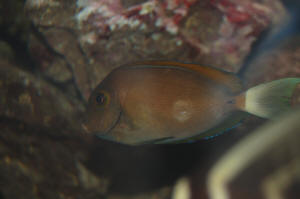
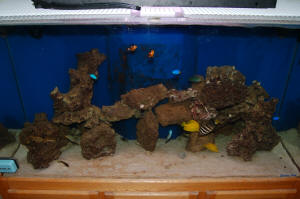
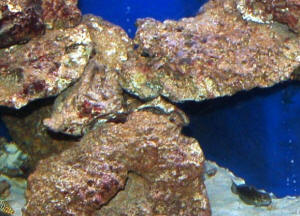 crop
crop |
|
Re: Septicemia on my yellow tangs 7/28/12
Dear Bob,
I guess I will go ahead and treat the tank with Chemiclean then
<Or any source of Erythromycin... WITH your close observations... ready to
change water and more... should the system disimprove quickly from the BGA
crashing>
(I just happen to have an almost brand new bottle a friend gave me when he
gave up on saltwater). Is there anything else I can do?
<... move out the LR, or move the fishes elsewhere>
When I treated the display with Cupramine, all of my Chaetomorpha in the
refugium died. I tried to go buy some mixed macro (Chaeto, Gracilaria and
Caulerpa) yesterday, but both of the nearby stores were out of all types of
macroalgae. I used to grow C. prolifera in the display but it was at the
point where my tank looked like a seagrass bed (which the filefish loved).
<MUCH better than the BGA>
I took it out because I read about all the instances of Caulerpa going
"sexual" and poisoning tanks online. The Astraea snails seem to like eating
it though, should I try adding some more snails?
<I wouldn't, no... you have too many already as far as I'm concerned. See
WWM re scavengers as such>
As for the Bariene tang, do you think it is just an injury healing itself
(he seems to be scraping it on the bottom and the rocks), or is it a
parasite or disease of some sort.
Thanks again,
Ashton Nietzke
<Welcome. Bob Fenner>
Re: Septicemia on my yellow tangs 7/30/12
Dear Bob,
I thought I'd give you an update, no matter how unpleasant it may be. The
erythromycin ended up making the algae grow much faster than before rather
than killing it.
<Mmm>
It now covers the bottom of the tank and all the sides. I think it is
actually a Dinoflagellate and not Cyanobacteria.
<Do you have a microscope? Take a look at a sample... easily distinguished>
I ended up getting a ball of Caulerpa racemosa and Caulerpa taxifolia, and
that is currently in my refugium.
<Okay>
When I went to the LFS to get the Caulerpa, I told them what was wrong
with the tank and they ended up selling me 2 sea urchins, a Halloween urchin
and a red spined blue tuxedo urchin (both of whom love Nori). They, along
with the 25 snails I already had, seem to be eating the Dinoflagellates, but
after reading about Dinoflagellates poisoning the animals that eat them, I
feel as if I should remove all the animals and put them in a different
system, and turning off all of the lights on the display for a few weeks. I
am pretty sure that I will divide the animals between my 30 gallon
quarantine (I feel as if the Zebrasoma will pick on the smaller bariene in
the 75 gallon) and my 75 gallon tank that currently has fancy goldfish in it
(I will move the goldfish to a kiddy-pool, change out all the freshwater for
saltwater, and add some bio-Spira for saltwater).
All of the invertebrates will go into the 75 gallon, since the larger water
volume should hopefully be more stable, and that tank hasn't been treated
with copper.
By the way, the bariene tang (which grazes this algae stuff more than the
others) looks the worst, and continues to get worse. The yellow tangs, both
of which eat it occasionally have septicemia still (and one is worse than
the other). The sailfin tang (which doesn't touch it at all), seems to be
having no problem, much like all of the other fish (which do not eat it
either). I plan on running over to the store in the morning and buying a 200
gallon box of instant ocean salt.
Is there anything else I can do?
<I'd add a great deal more small substrate to the refugium and/or
main/display tank, AND look into what your RedOx is... raise it w/ ozone
addition. This is, as the saying goes, WAR>
Thanks again for putting up with all my emails,
Ashton Nietzke
<Welcome. BobF>
Re: Septicemia on my yellow tangs
8/2/12
Dear Bob,
<Ashton>
I thought I'd give you a follow up on the algae problem. Two
nights ago I removed all of the animals in the tank and moved them into
quarantine.
Unfortunately, the bariene tang died that night. As for the
other fish, all of them seem 100% better, including the two yellow tangs
which have no more red on them at all.
<Ahh, good>
The tank is currently sitting in the dark with the lights off and is
covered with a black tarp. I also raised the pH to 8.5 and began running
a pound of activated carbon in the sump based on recommendations from
the LFS and others online who have dealt with Dinoflagellate problems. I
will say that after moving the fish, snails, and urchins (and having my
arms in the water for quite some time afterwards scrubbing the
walls and rocks) that I got quite the headache and felt quite sick to my
stomach.
<Mmm, me no like>
Luckily, the queasy feeling and the headache have just about gone away
now.
Needless to say, I will be investing in a pair of arm length rubber
gloves after this incident.
<Good>
Thanks for putting up with my emails,
Ashton Nietzke
<Thanks for this update. B>
Surgeonfishes: Tangs for Marine Aquariums
Diversity, Selection & Care
New eBook on Amazon: Available here
New Print Book on Create Space: Available
here
by Robert (Bob) Fenner |
 |
|
|
|

